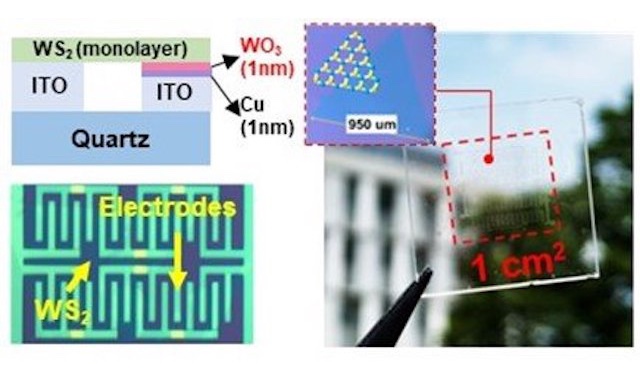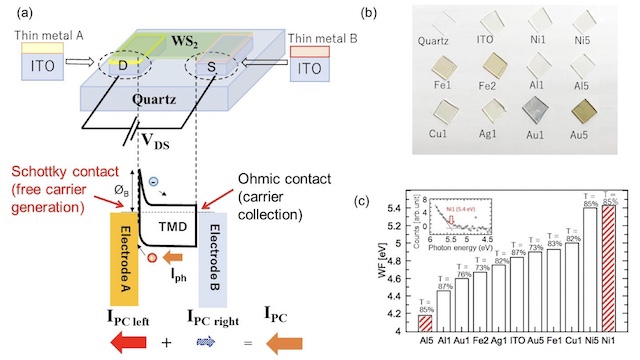

Highly transparent solar cell: Power generation efficiency is improved 1000 times!
-Passes 80% of visible light-
-Succeeded in generating 420pW with a 1㎠ solar cell-
Tohoku University:
July 12, 2022,
The research group has developed a “nearly transparent solar cell that allows 80% of visible light to pass through.”
New high-transparency solar cell:
Highly transparent solar cells can be installed in various places.
It is attracting attention as “clean energy that can be ignored and is in harmony with the environment.”
Existing transparent solar cells:
On the other hand, many of the existing transparent solar cells have “visible light transmittance of 60% or less”.
Existing research:
In existing research,
“Opaque nickel (Ni) or palladium (Pd) bulk metal” is used for the electrodes.
Therefore, a transparent solar cell has not been realized.
This study:
this time,
As a “semiconductor two-dimensional sheet with a thickness on the order of atoms”
“Transition metal dichalcogenide (TMD)” was adopted.
Transparent electrode
Uses ITO electrode
In this study, we used a Schottky atomic layer solar cell as a base.
A transparent ITO electrode is newly adopted.
On the surface of the ITO electrode,
Deposit a metal thin film of several nm or less,
It controls the work function of the ITO electrode.
As a result, the type and film thickness of the metal thin film to be inserted were adjusted.
The height of the Schottky barrier at the TMD junction can be freely controlled without impairing the transparency of ITO.
Power generation efficiency improved 1000 times:
In the charge separation region and carrier collection region,
We selected the optimum metal thin film / ITO structure, manufactured the device, and compared the photovoltaic power generation performance.
Then,
Compared to using only simple ITO electrodes,
With the optimized metal thin film / ITO electrode structure, the power generation efficiency has improved more than 1000 times.
Research on large area:
In addition, “research on increasing the area required for the practical application of highly transparent solar cells” was also conducted.
Measures to reduce open circuit voltage:
The area of the basic unit structure,
Simply expanding to the cm scale does not increase total power generation.
It was found that “the open circuit voltage decreases as the area increases”.
Suppresses open circuit voltage drop:
To suppress the drop in open circuit voltage
It was designed as “calculate the aspect ratio from the electrode width and length (less than a certain value)”.
Then,
It turned out that “the total amount of power generation increases as the device area increases.”
Large-scale integration of TMD solar cells:
Based on this
A large-scale integration of TMD solar cells on a 1 ㎠ quartz substrate.
We succeeded in generating 420pW solar power with a visible light transmittance of about 80%.
Commercially available small sensor
Electronic device
The small sensors currently on the market with low power consumption are
Electronic devices operate on 100pW of power.
Even the 1㎠ highly transparent solar cell produced this time can be sufficiently driven.
Fields of application of highly transparent solar cells:
By increasing the area and modularization,
Building windows and car windshields,
With glasses, human skin, etc.
This will lead to the practical application of highly transparent solar cells.
–fabcross for engineer
https://engineer.fabcross.jp/archeive/220713_tohoku_u.html
Cellule solaire hautement transparente : l’efficacité de la production d’énergie est améliorée 1000 fois !
-Passe 80% de la lumière visible-
-A réussi à générer 420pW avec une cellule solaire 1㎠-
Université du Tohoku :
12 juillet 2022,
Le groupe de recherche a développé une “cellule solaire presque transparente qui laisse passer 80% de la lumière visible”.
Nouvelle cellule solaire haute transparence :
Des cellules solaires hautement transparentes peuvent être installées à divers endroits.
Elle attire l’attention comme “une énergie propre qui peut être ignorée et qui est en harmonie avec l’environnement”.
Cellules solaires transparentes existantes :
D’autre part, de nombreuses cellules solaires transparentes existantes ont une “transmission de la lumière visible de 60 % ou moins”.
Recherche existante :
Dans les recherches existantes,
Pour les électrodes, on utilise du “métal opaque nickel (Ni) ou palladium (Pd) massif”.
Par conséquent, une cellule solaire transparente n’a pas été réalisée.
Cette étude:
cette fois,
En tant que “feuille bidimensionnelle semi-conductrice d’une épaisseur de l’ordre des atomes”
“Dichalcogénure de métal de transition (TMD)” a été adopté.
Électrode transparente
Utilise l’électrode ITO
Dans cette étude, nous avons utilisé une cellule solaire à couche atomique Schottky comme base.
Une électrode ITO transparente est nouvellement adoptée.
A la surface de l’électrode ITO,
Déposer une couche mince métallique de quelques nm ou moins,
Il contrôle la fonction de travail de l’électrode ITO.
En conséquence, le type et l’épaisseur du film mince métallique à insérer ont été ajustés.
La hauteur de la barrière Schottky à la jonction TMD peut être contrôlée librement sans nuire à la transparence de l’ITO.
Efficacité de la production d’énergie améliorée 1000 fois :
Dans la région de séparation des charges et la région de collecte des porteurs,
Nous avons sélectionné la structure optimale couche mince métallique / ITO, fabriqué le dispositif et comparé les performances de production d’énergie photovoltaïque.
Alors,
Par rapport à l’utilisation de simples électrodes ITO,
Grâce à la structure optimisée des électrodes à couche mince métallique / ITO, l’efficacité de la production d’énergie s’est améliorée plus de 1000 fois.
Recherche sur grande surface :
En outre, “des recherches sur l’augmentation de la surface requise pour l’application pratique de cellules solaires hautement transparentes” ont également été menées.
Mesures pour réduire la tension en circuit ouvert :
La zone de la structure de l’unité de base,
Une simple extension à l’échelle du centimètre n’augmente pas la production totale d’énergie.
Il a été constaté que “la tension en circuit ouvert diminue à mesure que la surface augmente”.
Supprime les chutes de tension en circuit ouvert :
Pour supprimer la chute de tension en circuit ouvert
Il a été conçu comme “calculer le rapport d’aspect à partir de la largeur et de la longueur de l’électrode (moins d’une certaine valeur)”.
Alors,
Il s’est avéré que “la quantité totale de production d’énergie augmente à mesure que la surface de l’appareil augmente”.
Intégration à grande échelle des cellules solaires TMD :
Basé sur ceci
Une intégration à grande échelle de cellules solaires TMD sur un substrat de quartz 1㎠.
Nous avons réussi à générer une énergie solaire de 420 pW avec une transmission de la lumière visible d’environ 80 %.
Petit capteur disponible dans le commerce
Appareil électronique
Les petits capteurs actuellement sur le marché à faible consommation sont
Les appareils électroniques fonctionnent avec une puissance de 100pW.
Même la cellule solaire hautement transparente de 1㎠ produite cette fois-ci peut être suffisamment entraînée.
Domaines d’application des cellules solaires hautement transparentes :
En augmentant la surface et la modularisation,
Construire des fenêtres et des pare-brise de voiture,
Avec des lunettes, de la peau humaine, etc.
Cela conduira à l’application pratique de cellules solaires hautement transparentes.
–fabcross pour ingénieur
Hochtransparente Solarzelle: Die Effizienz der Stromerzeugung wird um das 1000-fache verbessert!
-Lässt 80 % des sichtbaren Lichts durch-
-Es gelang, 420pW mit einer 1㎠-Solarzelle zu erzeugen-
Universität Tohoku:
12. Juli 2022,
Die Forschungsgruppe hat eine „nahezu transparente Solarzelle entwickelt, die 80 % des sichtbaren Lichts durchlässt“.
Neue hochtransparente Solarzelle:
Hochtransparente Solarzellen können an verschiedenen Stellen verbaut werden.
Sie erregt Aufmerksamkeit als “saubere Energie, die ignoriert werden kann und im Einklang mit der Umwelt steht”.
Bestehende transparente Solarzellen:
Andererseits haben viele der bestehenden transparenten Solarzellen eine “Durchlässigkeit für sichtbares Licht von 60 % oder weniger”.
Bestehende Forschung:
In der bestehenden Forschung,
Für die Elektroden wird “undurchsichtiges Nickel (Ni) oder Palladium (Pd)-Massenmetall” verwendet.
Daher wurde eine transparente Solarzelle nicht realisiert.
Diese Studie:
diesmal,
Als “zweidimensionale Halbleiterfolie mit einer Dicke in der Größenordnung von Atomen”
“Übergangsmetalldichalkogenid (TMD)” wurde angenommen.
Transparente Elektrode
Verwendet ITO-Elektrode
In dieser Studie haben wir eine Schottky-Atomschicht-Solarzelle als Basis verwendet.
Neu eingeführt wird eine transparente ITO-Elektrode.
Auf der Oberfläche der ITO-Elektrode
Abscheiden eines Metalldünnfilms von mehreren nm oder weniger,
Es steuert die Austrittsarbeit der ITO-Elektrode.
Als Ergebnis wurden die Art und Filmdicke des einzufügenden Metalldünnfilms eingestellt.
Die Höhe der Schottky-Barriere am TMD-Übergang kann frei gesteuert werden, ohne die Transparenz von ITO zu beeinträchtigen.
Die Effizienz der Stromerzeugung wurde um das 1000-fache verbessert:
In der Ladungstrennungsregion und der Ladungsträgersammelregion,
Wir haben die optimale Metalldünnschicht/ITO-Struktur ausgewählt, das Gerät hergestellt und die Leistung der photovoltaischen Stromerzeugung verglichen.
Dann,
Im Vergleich zur Verwendung nur einfacher ITO-Elektroden
Mit der optimierten Metalldünnschicht-/ITO-Elektrodenstruktur hat sich die Effizienz der Stromerzeugung um mehr als das 1000-fache verbessert.
Forschung auf großer Fläche:
Darüber hinaus wurden „Forschungen zur Vergrößerung des Flächenbedarfs für die praktische Anwendung hochtransparenter Solarzellen“ durchgeführt.
Maßnahmen zur Reduzierung der Leerlaufspannung:
Der Bereich der grundlegenden Einheitsstruktur,
Eine einfache Erweiterung auf die cm-Skala erhöht die Gesamtstromerzeugung nicht.
Es wurde festgestellt, dass “die Leerlaufspannung mit zunehmender Fläche abnimmt”.
Unterdrückt den Leerlaufspannungsabfall:
Um den Abfall der Leerlaufspannung zu unterdrücken
Es wurde so konzipiert, dass “das Seitenverhältnis aus der Elektrodenbreite und -länge (weniger als ein bestimmter Wert) berechnet wird”.
Dann,
Es stellte sich heraus, dass “die Gesamtmenge der Stromerzeugung mit zunehmender Gerätefläche zunimmt”.
Großtechnische Integration von TMD-Solarzellen:
Basierend auf
Eine großtechnische Integration von TMD-Solarzellen auf einem 1 ㎠ Quarzsubstrat.
Es ist uns gelungen, 420 pW Solarenergie mit einer Durchlässigkeit für sichtbares Licht von etwa 80 % zu erzeugen.
Handelsüblicher kleiner Sensor
Elektronisches Gerät
Die derzeit auf dem Markt befindlichen kleinen Sensoren mit geringem Stromverbrauch sind
Elektronische Geräte werden mit einer Leistung von 100 pW betrieben.
Auch die diesmal produzierte 1㎠ hochtransparente Solarzelle kann ausreichend angesteuert werden.
Anwendungsgebiete hochtransparenter Solarzellen:
Durch Flächenvergrößerung und Modularisierung
Bau von Fenstern und Autoscheiben,
Mit Brille, menschlicher Haut usw.
Dies wird zur praktischen Anwendung von hochtransparenten Solarzellen führen.
–fabcross für Ingenieur
Schottky solar cell using few-layered transition metal dichalcogenides toward large-scale fabrication of semitransparent and flexible power generator
Scientific Reports
Abstract
Few-layered transition metal dichalcogenides (TMDs)
are known as true two-dimensional materials, with excellent semiconducting properties and strong light–matter interaction.
Thus,
TMDs are attractive materials for semitransparent and flexible solar cells for use in various applications.
Hoewver,
despite the recent progress,
the development of a scalable method to fabricate semitransparent and flexible solar cells with mono- or few-layered TMDs remains a crucial challenge.
Here,
we show easy and scalable fabrication of a few-layered TMD solar cell using a Schottky-type configuration to obtain a power conversion efficiency (PCE) of approximately 0.7%,
which is the highest value reported with few-layered TMDs.
Clear power generation
was also observed for a device fabricated on a large SiO2 and flexible substrate,
demonstrating that our method has high potential for scalable production.
In addition,
systematic investigation revealed that
the PCE and external quantum efficiency (EQE) strongly depended on the type of photogenerated excitons (A, B, and C) because of different carrier dynamics.
Because high solar cell performance along with excellent scalability
can be achieved through the proposed process, our fabrication method will contribute to accelerating the industrial use of TMDs as semitransparent and flexible solar cells.